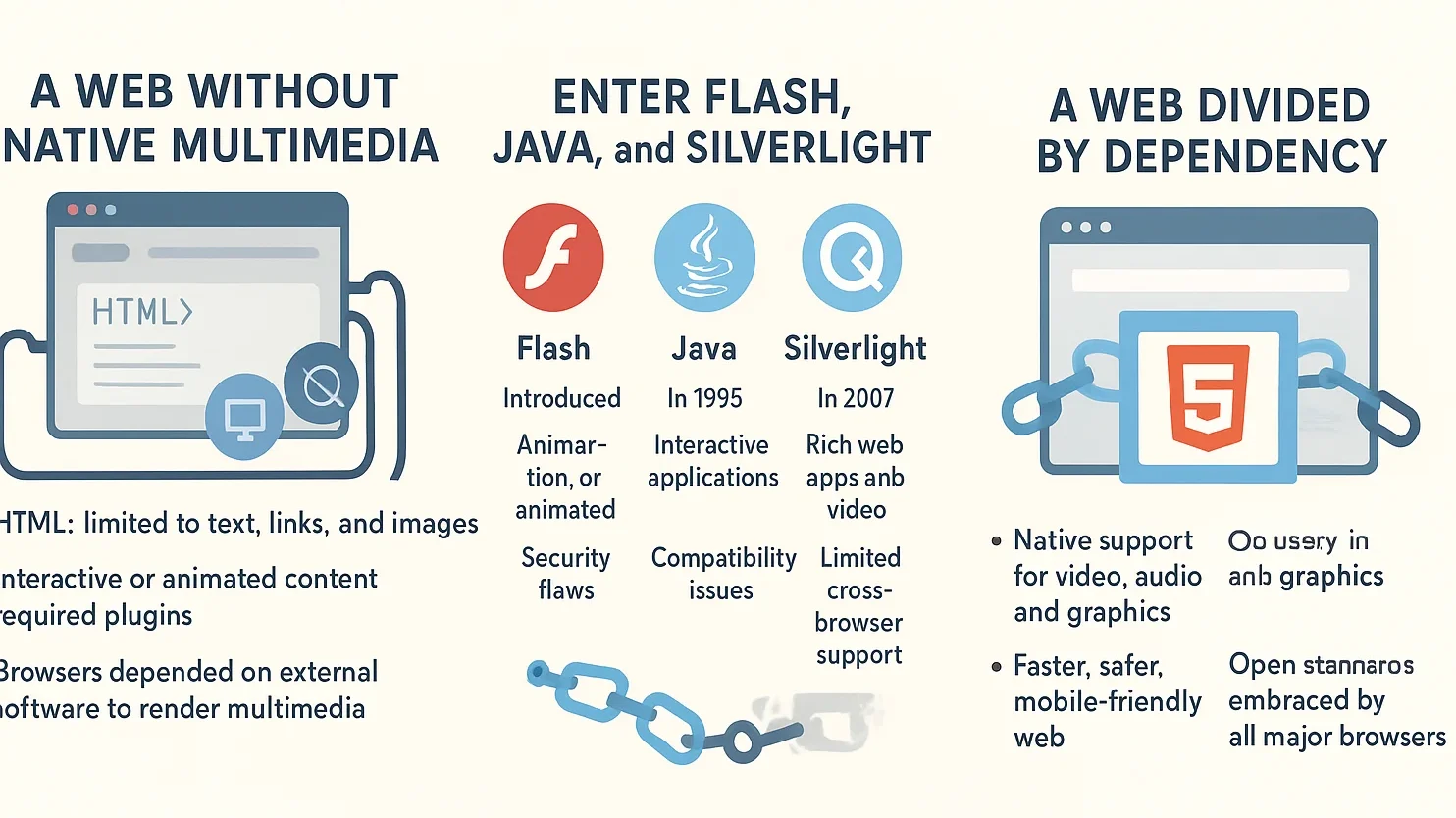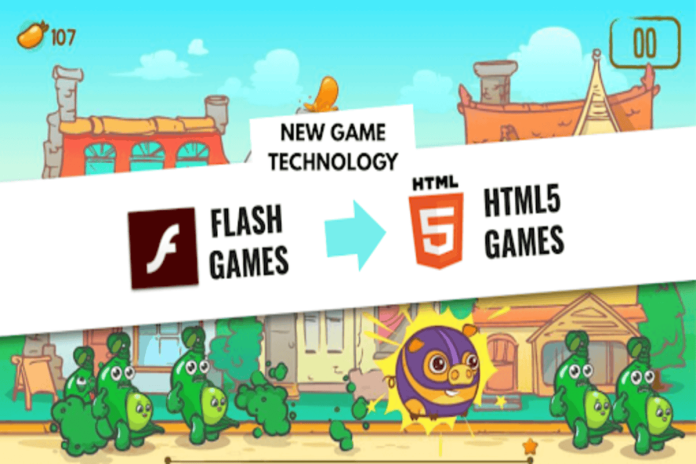HTML5 represents far more than an incremental update to web markup language. It stands as a transformative catalyst that has fundamentally restructured the digital entertainment landscape. For over a decade, the browser gaming ecosystem remained constrained by the proprietary architecture and inherent limitations of Adobe Flash. This technology monopolized interactive web content while simultaneously creating critical vulnerabilities in performance, security, and cross-platform compatibility.
The decline of Flash was not a random event. It was the holonymic consequence of market demand for open, flexible standards. This article analyzes three core facets: core technology (Canvas, WebGL), new business models (Free-to-Play/IAP), and the cross-platform user experience. These will be presented in this sequence.
Key Takeaways
- HTML5 revolutionized the web by moving away from proprietary plugins like Adobe Flash, enhancing performance and security.
- The adoption of HTML5 was driven by market demand for open standards, particularly following Apple’s exclusion of Flash from iOS.
- Core HTML5 technologies, such as WebGL and Canvas, empowered developers to create sophisticated browser-based applications without external dependencies.
- HTML5 reshaped gaming economics, promoting Free-to-Play models and expanding market reach across devices and platforms.
- With its robust structure, HTML5 provides a safer gaming environment while paving the way for future trends like cloud gaming.
Table of Contents
- The Pre-HTML5 Era: A Web Constrained by Proprietary Plugins
- The Catalyst for Transformation: Market Forces Driving HTML5 Adoption
- Core HTML5 Technologies That Revolutionized Interactive Web Experiences
- The Business Revolution: Economic Models and Market Expansion
- What are Some Popular HTML5 Games?
- Where can we en joy HTML5 Browser Games?
- Is HTML5 A Safer Playground for Players?
- Is Cloud Gaming the Next Browser Revolution?
The Pre-HTML5 Era: A Web Constrained by Proprietary Plugins
The digital landscape preceding HTML5’s emergence was characterized by technological fragmentation and dependency on third-party plugins, with Adobe Flash serving as the dominant yet problematic platform for interactive content delivery. However, it has some limitations, especially for users trying to reopen recently closed tabs when the content failed to load properly.
- Proprietary Technology and Licensing Costs: Technologies such as Flash and Microsoft Silverlight operated under a monopolistic model, imposing high licensing fees on developers.
- Poor Performance and Mobile Incompatibility: Plugins consumed excessive computer resources, leading to low performance and, crucially, a lack of support on major mobile operating systems.
- Frequent Security Flaws: Flash was notorious for its security loopholes, making it a constant target for cyber threats.

The Catalyst for Transformation: Market Forces Driving HTML5 Adoption
The fundamental catalyst precipitating this technological revolution was the explosive proliferation of mobile computing devices. When Apple’s Steve Jobs published his famous “Thoughts on Flash” letter in 2010 and definitively excluded Flash from iOS, it sent a clear message throughout the industry. The future web would be universally accessible, standards-based, and plugin-free.
HTML5 emerged not as a competitive product but as an open specification. It was collaboratively developed through the World Wide Web Consortium (W3C) and the Web Hypertext Application Technology Working Group (WHATWG). This transition represented more than technical evolution. It embodied a market correction addressing the strategic imperative of ensuring content universality across heterogeneous device ecosystems, operating systems, and form factors.
Secondary Drivers of Adoption:
- Enterprise Security: Plugin-free environments reduced security risks and simplified patch management.
- Cost Efficiency: Open standards eliminated licensing fees, making web app development more affordable.
- SEO Benefits: HTML5’s semantic structure improved content discoverability and search indexing.
Core HTML5 Technologies That Revolutionized Interactive Web Experiences
HTML5 introduced an integrated technology stack. It enables developers to build complex, performant applications entirely within the native browser. It eliminates external dependencies.
| Technology | Function | Business Impact |
|---|---|---|
| WebGL | This technology enables complex 3D graphics, utilizing the GPU for acceleration. | Opened up new game genres (e.g., 3D strategy, simulation) and potential revenue streams. |
| Canvas API | This tool provides a dedicated 2D/3D rendering surface directly in the browser. | Completely replaced the drawing capabilities with better performance. |
| Web Audio API | This feature allows control over low-latency audio and complex spatial sound. | Enhancing the user experience is a prerequisite for high-quality games. |
| WebSockets | Enables bidirectional real-time communication. | Key for multiplayer games, reducing lag and enhancing interactivity. |
The Business Revolution: Economic Models and Market Expansion
HTML5 catalyzed a fundamental restructuring of gaming economics. It transitioned from advertisement-dependent and upfront licensing models to sophisticated Free-to-Play (F2P) frameworks. These are augmented by In-App Purchases (IAP) and optional cosmetic microtransactions.
The Economic Transformation:
- Market Accessibility: Removing technical barriers lowered customer acquisition costs and reduced onboarding abandonment rates (60-80%).
- Monetization: Integration with payment APIs (Stripe, PayPal) enabled seamless transactions and real-time optimization of pricing, virtual goods, and promotions.
- Mobile Market Reach: HTML5 games worked across desktop and mobile, tapping into the mobile gaming market. This market accounts for over 50% of global revenue.
- Live Operations: Server-side content delivery supported time-limited events, boosting player lifetime value by 3- 5x.
- Cross-Platform Progression: Unified tech allowed players to retain progress across devices, increasing engagement and reducing churn.
Market Growth: According to a report, the global HTML5 Games Market was valued at USD 5.32 billion in 2024. It is projected to grow to USD 9.22 billion by 2033, representing a compound annual growth rate (CAGR) of approximately 6.3%. This substantial market expansion reflects the ongoing maturation of HTML5 gaming monetization mechanisms. It also shows the continued displacement of legacy plugin-based technologies. Moreover, the increasing sophistication of browser-based gaming experiences now competes directly with native mobile and desktop applications.
What are Some Popular HTML5 Games?
The HTML5 gaming ecosystem has produced numerous titles that showcase the platform’s capabilities while achieving mainstream popularity and cultural impact. These games demonstrate the technical maturity and commercial viability of browser-based experiences, including:
- Action Games: Stick Defenders, Run 3, Vex 6, Fireboy and Watergirl, Short Life 2, Stickman Hook, Temple Run 2, Fancy Pants Adventure
- Driving Games: Moto X3M, Drift Hunters, Madalin Stunt Cars 3, Burnin’ Rubber 5, Hill Climb Racing, Scrap Metal 3, Traffic Racer, Car Simulator Arena
- Shooting Games: Krunker.io, Shell Shockers, Bullet Force, Combat Reloaded, War Brokers, Rebel Forces, Mini Royale 2, Masked Forces
- Arcade Games: Agar.io, Slither.io, 2048, Crossy Road, Pac-Man, Geometry Dash Online, Helix Jump, Stack Ball
- Skill Games: Paper.io, Cut the Rope, Flappy Bird, Happy Wheels, Little Alchemy 2, Doodle Jump, Elastic Man, Slope
- Sport Games: 2 Minute Football, Basketball Stars, Soccer Physics, Tennis Masters, Mini Golf Club, 8 Ball Pool, Stickman Skate Battle, Table Tennis World Tour.

Where can we enjoy HTML5 Browser Games?
The beauty of HTML5 is that it ushered in an era of accessible, frictionless gaming. It enables the development of high-quality games that run directly in the browser without downloads or plugins.
For users, especially those in school or office environments where application installation is typically blocked, the following HTML5 portals offer a vast, free, and unblocked gaming experience:
- Poki
- CrazyGames
- Cool Math Games
- 1001Games
- AntGames
- Now.gg
- HahaGames
Is HTML5 A Safer Playground for Players?
HTML5 has ushered in a safer playground. Additionally, the browser’s modern sandbox environment mitigates many of the infamous security flaws associated with Flash plugins. Although web security remains an ongoing battle, the shift to open, well-vetted standards has transitioned the focus. It moved from patching proprietary plugin errors to improving browser-level network security.
Is Cloud Gaming the Next Browser Revolution?
The Flash-to-HTML5 transition has a striking parallel with the potential shift to Cloud Gaming. If HTML5 brought games to the browser, Cloud Gaming brings them from the server. This turns the browser into a pure display device. This strategic question remains: Will the browser become the standard port for all digital experiences, underpinned by open standards?
HTML5 was a watershed moment, reaffirming that adaptability to open standards and platform shifts is key to survival in tech. However, the core lesson for leaders today is that innovation comes not just from creating new tech. It also comes from optimizing the access environment and prioritizing a frictionless user experience.











